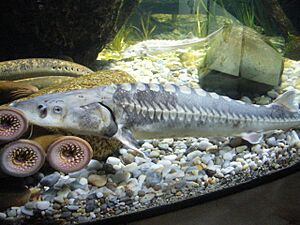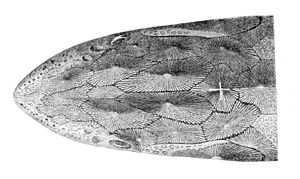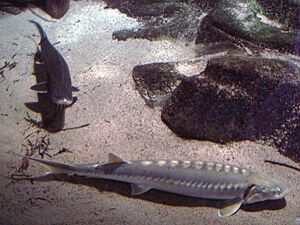Adriatic sturgeon facts for kids
Quick facts for kids Acipenser naccarii |
|
|---|---|
 |
|
| Adriatic sturgeon with sea lampreys in the Aquarium Finisterrae, Spain | |
| Conservation status | |
| Scientific classification | |
| Genus: |
Acipenser
|
| Species: |
naccarii
|
| Synonyms | |
|
|
The Adriatic sturgeon (Acipenser naccarii) is a special type of fish. It lives in the Adriatic Sea and the big rivers that flow into it. You can find it near countries like Albania, Greece, Italy, Montenegro, Croatia, Bosnia and Herzegovina, and Slovenia. If you want to see one, some aquariums like the Milan Aquarium and Aquarium Finisterrae have them.
Contents
What Does the Adriatic Sturgeon Look Like?
The Adriatic sturgeon can grow very long, over 2 meters (about 6.5 feet)! Some large wild fish caught recently weighed more than 40 kg (about 88 pounds).
Like other sturgeons, it has a long body. Its tail is shaped like a shark's tail, with the top part longer than the bottom. Its skeleton is partly made of cartilage, which is softer than bone. It has smooth skin and five rows of bony plates called scutes along its body.
The sturgeon's snout (nose) is usually cone-shaped and quite short. Its head is wide and rounded. It has a mouth that can stick out, with a thin lower lip that has a split in the middle. It also has four whisker-like feelers called barbels. These barbels are closer to the tip of its snout than to its mouth.
The five rows of bony plates are:
- One row on its back (10–14 plates)
- Two rows on its sides (30–42 plates each)
- Two rows on its belly (8–11 plates each)
The fin on its back has no sharp spines, but 36 to 48 soft rays. The fin on its belly has 24 to 31 soft rays. The sturgeon's back is olive-brown, its sides are lighter, and its belly is white. Young sturgeons have a flatter, triangle-shaped snout. They also have a unique dark brown color on their back with lighter spots.
The Adriatic sturgeon looks a lot like the European sea sturgeon (Acipenser sturio). Both used to live in the Adriatic Sea. However, the Adriatic sturgeon has:
- A shorter, thicker snout.
- A darker, brown back.
- Fewer and smaller bony plates on its sides.
- A larger mouth.
- Barbels closer to the tip of its snout (the European sturgeon's barbels are closer to its mouth).
- Its mouth ends just after the front of its gill cover.
- It is generally smaller.
Where Do Adriatic Sturgeons Live?
The Adriatic sturgeon can live in both fresh water (like rivers) and salt water (like the sea). It also lives in estuaries, where rivers meet the sea, and in brackish water (a mix of fresh and salt water).
Historically, it was found in the Adriatic Sea and the rivers flowing into it. In 1932, it was reported to live in the sea from Venice and Trieste down to Greece. It used to be in many Italian rivers like the Adige, Brenta, Piave, and Po. It was also found along the coasts of Albania and in rivers in Slovenia, Croatia, Bosnia-Herzegovina, and Montenegro, including Lake Skadar.
How Do Adriatic Sturgeons Live?
Scientists once thought the Adriatic sturgeon always migrated from the sea to rivers to lay eggs. However, a recent study suggests they can live in both salty and fresh water. They spend most of their lives in the lower parts of rivers. This study found that some sturgeons could even lay eggs and live their whole lives in a river without going to the sea. This is different from other sturgeon species that must migrate to the sea.
Reproduction and Life Cycle
Adriatic sturgeons grow slowly and live a long time. Male sturgeons are ready to reproduce when they are 7–11 years old (about 80 cm or 2.6 feet long). Females are ready at 12–14 years old (at least 1 meter or 3.3 feet long). Females lay eggs every 2–4 years.
In spring, adult fish swim upstream to the deeper parts of rivers. They lay their eggs from April to June in deep, oxygen-rich waters. They prefer gravelly riverbeds that are 2–10 meters (6.5–33 feet) deep, with a strong current. The moving water helps keep the eggs healthy and safe from predators.
The eggs stick to the riverbed and hatch after about a week. The baby sturgeons are tiny, about 8–10 mm (0.3–0.4 inches) long. They float in the water for about ten days before they start to live on the bottom.
What Do Adriatic Sturgeons Eat?
Adriatic sturgeons are not picky eaters. They often swallow sand and mud along with their food. In rivers, they mostly eat small crustaceans called gammarids, insect larvae, and worms. Sometimes they eat small fish. They suck up their food with their toothless, funnel-shaped mouths. They might also eat freshwater clams, which are now common in some rivers.
In the sea, they eat gammarids, shrimp, crabs, fish that live on the seabed, and mollusks (like clams and snails). They also eat some plant matter. Scientists have found sand, mud, and even plastic mixed with food in their stomachs.
Where Do Adriatic Sturgeons Prefer to Live?
The Adriatic sturgeon usually lives in large, deep rivers with strong currents that flow into the Adriatic Sea. In the sea, they prefer lagoons and areas near river mouths. They mostly live on muddy and sandy bottoms, at depths of 10–40 meters (33–130 feet).
Young Adriatic sturgeons can handle water with some salt, but adult sturgeons don't like very salty water for long periods. They usually only go into the sea for short times to find food. This means they don't migrate far across the Adriatic Sea, where the water is very salty. Studies have shown that they prefer areas where the salt from the sea mixes with river water, creating slightly salty conditions.
Genetic Information
A study looked at the genes of Adriatic sturgeons. It found that sturgeons from the Po River basin are genetically different from those in the Buna River basin. This means that if sturgeons from the Po River were moved to the Buna River, it could harm the unique genetic makeup of the Buna population. So, it's important to keep these groups separate.
Conservation Status: Are They in Danger?
Official Status
The International Union for Conservation of Nature (IUCN) says this fish is "critically endangered" and possibly "extinct in the wild." For a long time, scientists didn't see any sturgeons reproducing naturally in the wild.
However, many groups are working to save this species. A program has been set up to breed them in captivity. Since 2004, young sturgeons with microchips have been released into rivers. Before 2004, mostly very small sturgeons were released. At that time, fishing for sturgeons was still allowed in Italy, and a foreign fish called the wels catfish was very common. This meant very few young sturgeons survived.
The breeding program started with about 50 adult sturgeons. Scientists are studying their genes to make sure the captive-bred fish have enough genetic variety.
Researchers reported in 2011 that they hadn't seen signs of wild sturgeons reproducing. But since Adriatic sturgeons take at least 12 years to become adults and only lay eggs every few years, it might have been too early to expect to see wild babies at that time.
In the southwestern part of their range, the Adriatic sturgeon was last seen in Greece in 1977 and in Albania in 1997. However, a 2003 study did find genetic information from some sturgeons caught in the Buna River.
Present Status (2020)
Recently, anglers (people who fish with a rod and line) have caught, filmed, and released adult Adriatic sturgeons in the Po River and other rivers. Some of these fish were very large and old.
In 2018, a project called GRAIA started monitoring a fish ladder (a special path for fish to swim over dams) on the Isola Serafini dam. Cameras are now watching fish as they pass through. Among millions of fish, adult Adriatic sturgeons have been filmed using this ladder.
Also, some young sturgeons have been caught that don't have microchips. This suggests they were born in the wild, not released from the breeding program. Genetic tests showed that some of these wild-born fish were not related to the captive breeding group. This is good news, as it means a wild population of Adriatic sturgeons might still exist!
Threats to Adriatic Sturgeons
The biggest danger to Adriatic sturgeons is damming. Dams break up their habitat and stop them from migrating to find food or lay eggs. Dams change rivers a lot:
- Upstream, the water can become very slow, cloudy, and have low oxygen.
- Downstream, the riverbed can change, and the water can become warmer and have less oxygen.
These changes make it hard for sturgeons to reproduce and for young sturgeons to survive. Before fish ladders were built, most of the traditional spawning areas in the Po River were blocked for decades. This caused the wild populations of Adriatic sturgeons, and other sturgeon species, to crash.
Another big problem is pollution in rivers from factories, farms, and cities.
In the 20th century, too much fishing of adult and young sturgeons also caused their numbers to drop. Even though they are now a protected species, illegal fishing is still a major threat in the Po River basin. This is especially harmful when smaller fish are caught before they have had a chance to reproduce. Illegal fishing with huge nets near river mouths and commercial fishing in the sea are also dangerous.
Cormorants (a type of bird) also eat young sturgeons. There are many cormorants in Italy, and their numbers are growing. Many are moving to rivers and lakes, which puts more pressure on young sturgeons.
Adriatic sturgeons also face competition from the wels catfish, which has spread into their areas. However, wels catfish live alongside many sturgeon species in their native homes. Some scientists think that because there are so few Adriatic sturgeons, they might be affected by something called the "Allee effect." This means that when a population is very small, its growth rate can slow down even more. However, no studies have confirmed this for the Adriatic sturgeon.
Images for kids









